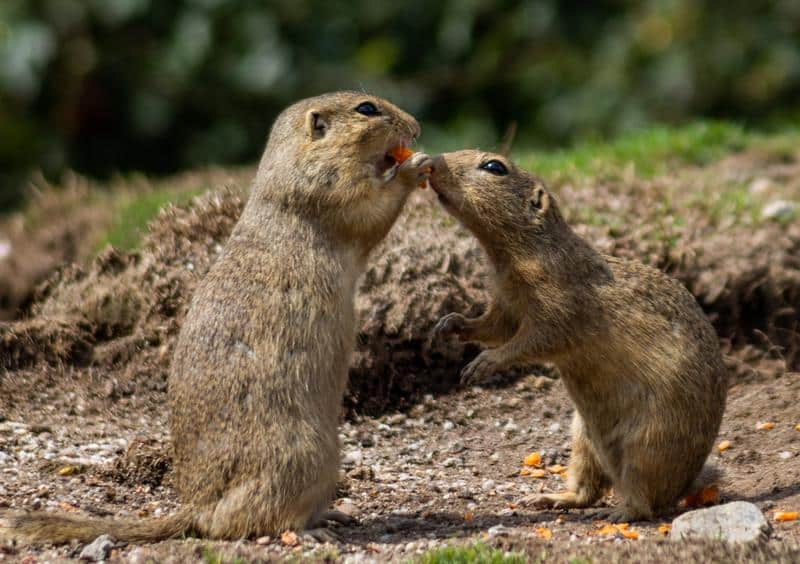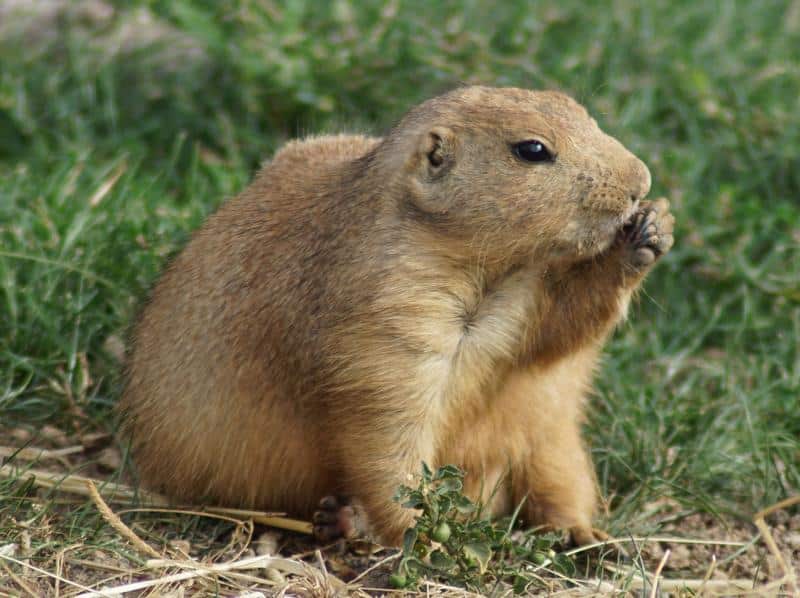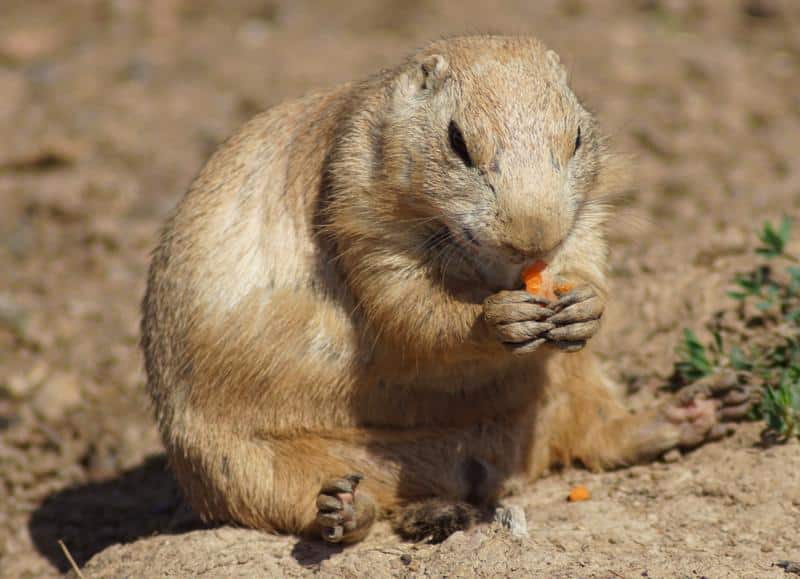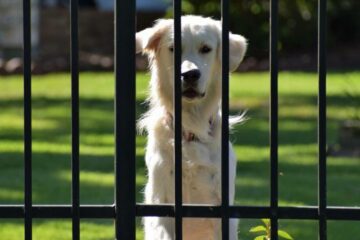Are Gophers Dangerous to Dogs? My Dog Ate a Gopher!
Are gophers dangerous to dogs? What do you do if your dog ate a gopher? In this article, we’ll answer everything you need to about these questions including a very easy-to-train command that will ensure you never have to deal with this rodent issue ever again.
Once we’ve covered the tough subjects like what you need to do if your dog killed a gopher, we’ll help you protect your pup by teaching you what to do if your dog eats gopher poison. Finally, we’ll finish with how to get rid of gophers naturally, what do gophers look like, where are gophers found, and what do gopher mounds look like. Keep reading!
Are Gophers Dangerous to Dogs?

Gophers are not dangerous to dogs. However, there are some risks associated with dogs encountering gophers. These can include potential bite injuries and the transmission of diseases or parasites. Furthermore, if a gopher has consumed poison, this could be harmful to dogs. It’s important to train your dog to avoid these interactions for their safety.
Do Gophers Bite Dogs?
While gophers are typically not aggressive, they may bite when they feel threatened, such as when a dog is trying to dig them out of their burrow. A gopher bite can lead to an infection if not treated properly, and it is also possible, although not common, for a gopher to transmit rabies through a bite.
In the event of a bite, it’s important to clean the wound thoroughly and consult a vet promptly, as this can help prevent infection and ensure any potential diseases are appropriately addressed.
Are Gophers Poisonous to Dogs?
Gophers are not poisonous to dogs themselves, but if a gopher has ingested poison meant to control its population, this could potentially harm a dog. If a dog eats a poisoned gopher, the poison can be passed on, leading to symptoms like lethargy, loss of appetite, and potentially severe illness.
Furthermore, ingestion of such a poison could result in significant harm to a dog’s internal organs. Therefore, it’s always advisable to seek veterinary assistance immediately if you suspect your dog has eaten a poisoned gopher.
How to Train the “Leave It” Command
- Start with a treat in both hands. Show your dog one enclosed fist with the treat inside and say “leave it.”
- Let your dog lick, sniff, and paw at your hand, but don’t open it. Once your dog stops trying and pulls away, give them the treat from the other hand.
- Repeat until your dog moves away from the first fist when you say “leave it.” Then, only give the treat when your dog makes eye contact with you, to ensure they’re focusing on you and not the distraction.
- Progress to more challenging situations, like dropping a treat on the floor, but always rewarding your dog for successfully leaving it.
These steps will get your dog to stop eating gophers, but it’s important to remember that the underlying behavioral issues (prey drive, curiosity, overexcitement, etc.) that were causing all of this to begin with will still be present. And until you address those, any positive changes you see are only going to be temporary.
“Well, how do I make these changes last?”
By getting your dog to truly choose to follow your direction, that’s how. I tried many times to write out how you can do that before deciding it made more sense to just link you to the free video series that explains it better than I’d ever be able to.
The series is by a man named Dan who is one of the world’s leading dog obedience trainers. In it, he teaches you how to put an end to things like your dog killing gophers and all other misbehavior using his fast and easy-to-follow methods.
In the first video, Dan will reveal to you why the two most common methods of dog training only doom you to failure. You can watch the video now by clicking here. Follow the proven system he’ll show you in his series and you’ll never have to spend another second worrying about your dog eating gophers ever again!
My Dog Ate a Gopher

If your dog ate a gopher, there’s no need for immediate panic, but it’s important to take action. Wild animals like gophers can carry parasites and diseases that can infect dogs, and if the gopher was poisoned, it could potentially harm your pet. Monitor your dog for any signs of illness, and contact a vet for advice.
Can Dogs Eat Gophers?
While dogs are naturally carnivorous and can consume a wide variety of meats, it’s not ideal for them to eat wild animals like gophers. Gophers can be carriers of various parasites, such as fleas and ticks, and diseases, including rabies. In addition, if a gopher has ingested poison, it can be transferred to your dog, potentially causing severe health issues.
What to Do Right Away
If you’ve discovered that your dog ate a gopher, here’s what you should do right away:
- Keep an eye on your dog for any signs of illness. Symptoms might include vomiting, diarrhea, loss of appetite, lethargy, or behavioral changes.
- Remove any remaining parts of the gopher from your dog’s reach to prevent them from eating more.
- Contact your vet and explain the situation. They may ask you to bring your dog in for an examination or give you specific instructions to monitor your dog’s condition.
Potential Risks and Complications
A dog eating a gopher can lead to several health risks and complications. As mentioned, there’s the risk of parasitic infections or diseases. There’s also the risk of secondary poisoning if the gopher had ingested poison. Furthermore, eating a whole gopher could potentially lead to gastrointestinal blockages, especially in smaller dogs.
Preventing Future Incidents
To prevent future incidents, it’s important to supervise your dog while they are outside, especially in areas known for gophers. You could also work on training commands like “leave it” to keep your dog from eating things they shouldn’t (we explain it in the first section). Providing a well-balanced diet can help reduce your dog’s temptation to hunt and eat wildlife.
Taking care of this now is a must because it will also keep your dog safe during any future encounters they’re going to have. You then won’t have to stress about remembering what to do if your dog ate a vole, your dog ate a mole, your dog ate a groundhog, or your dog ate a slug, because you’ll your pet will keep their distance.
My Dog Killed a Gopher

If your dog killed a gopher, it’s important to prevent them from eating it, as gophers can carry diseases and parasites that can infect dogs. Monitor your dog for signs of illness and contact your vet if any symptoms occur. It’s also a good idea to consider training or preventative measures to avoid similar incidents in the future.
Dogs and Gophers: An Instinctual Predatory Behavior
Dogs are naturally predatory animals, and their instincts might drive them to chase and even kill small animals like gophers. This behavior can be particularly strong in breeds originally bred for hunting or chasing game. However, even if it’s instinctual, it’s essential to discourage this behavior due to the potential health risks that gophers pose.
What to Do After Your Dog Kills a Gopher
Here are some steps you can take after your dog kills a gopher:
- Prevent your dog from eating the gopher. As mentioned earlier, gophers can carry diseases and parasites which can be harmful to dogs.
- Dispose of the dead gopher safely and promptly to prevent your dog or other animals from accessing it.
- Observe your dog for any signs of illness or discomfort, as these could be symptoms of a disease contracted from the gopher.
- Contact your vet and let them know about the incident. They may suggest a check-up or specific preventative treatments.
Potential Risks of Dogs Killing Gophers
Apart from the potential for disease and parasite transmission, there are other risks involved when dogs interact with gophers. For instance, dogs might sustain injuries while chasing or capturing gophers, like cuts, scratches, or even bites. If the gopher was poisoned, there’s also a risk of secondary poisoning for your dog.
How to Prevent Future Incidents
To avoid future incidents, supervision is key. Keep an eye on your dog when they’re outside, especially in areas known to have gophers. Training your dog with commands like “leave it” can also help control their behavior around wildlife (learn it in the first section). You might also consider pest control measures to keep gophers out of your yard, as long as they’re safe for your pets.
What to Do if Your Dog Eats Gopher Poison

If your dog eats gopher poison, you need to act fast. Contact your vet immediately, as gopher poison can be lethal to dogs. Depending on the type of poison ingested and the amount, the effects can range from mild to severe. It’s important to recognize the symptoms and take immediate action to ensure your pet’s safety.
Dog Ate Gopher Poison: Immediate Actions
Once you suspect or know that your dog ate gopher poison, time is of the essence. Follow these steps:
- Do not try to induce vomiting unless instructed by a veterinarian. Depending on the type of poison, this could potentially cause more harm.
- Contact your veterinarian or a local emergency vet clinic immediately. Provide as much information as possible, including the type of poison (if known), the estimated amount ingested, and when it happened.
- If your vet is unavailable, reach out to a pet poison helpline. Keep the packaging of the poison, as it may contain critical information for the treatment plan.
Symptoms of Gopher Poison in Dogs
Recognizing the signs of poisoning can help you take swift action. Symptoms may vary based on the type of gopher poison, but some common signs include:
- Vomiting or diarrhea
- Lack of appetite or difficulty eating
- Weakness or lethargy
- Difficulty breathing
- Unusual behavior such as restlessness or aggression
- Bleeding or bruising
- Seizures
Preventing Gopher Poison Exposure
Prevention is the best medicine. Here are some tips to help prevent your dog from coming into contact with gopher poison:
- Use pet-safe pest control methods.
- Store all pesticides and poisons out of reach of pets.
- Monitor your dog while outside, especially in areas known to have gophers or where poison might be used.
- Train your dog the “leave it” command to control their behavior around potentially harmful substances. We explain it in the first section.
Long-Term Effects and Treatment
Long-term effects of gopher poison ingestion depend on several factors, such as the type and quantity of poison ingested and how quickly treatment was received. Treatment typically involves inducing vomiting, administering activated charcoal to absorb the poison, and symptomatic support like fluids and medications.
With swift action and proper veterinary care, dogs can recover from gopher poison ingestion.
How to Get Rid of Gophers Naturally

Getting rid of gophers naturally from your yard involves strategies such as using natural repellents, introducing predator scents, maintaining your garden, and installing physical barriers. These methods are safe and eco-friendly, making them suitable for yards shared with pets.
- Natural Repellents: Various natural substances like castor oil, garlic, and coffee grounds can help deter gophers. Spread these in your garden and around gopher mounds to discourage their presence.
- Predator Scents: Gophers are naturally wary of predators. Using predator urine or hair (from animals like cats or foxes) can scare them away. However, remember to change the scent materials regularly as they can lose effectiveness over time.
- Physical Barriers: Install physical barriers, like mesh or hardware cloth, particularly around prized plants or garden beds. Bury the barrier at least 2 feet deep as gophers are good diggers.
- Garden Maintenance: Regularly maintaining your garden can help control gopher populations. Keeping your lawn mowed and removing their food sources (certain types of plants and vegetables) can make your yard less appealing to them.
Getting rid of gophers naturally involves using repellents, predator scents, installing physical barriers, and maintaining your garden to deter their presence. These strategies are safe for pets and help preserve the natural ecosystem of your yard. Learn the command to keep your dog safe in the first section.
What Do Gophers Look Like?
Gophers are small, burrowing rodents known for their destructive digging habits. They typically have brown fur, small ears, a short tail, and large incisors that protrude from the mouth. Gophers have strong forelimbs that are built for digging. They are about 6 to 8 inches long and have cheek pouches to carry food.
When Are Gophers Most Active?
Gophers are mostly active during the day, particularly in the early morning and late afternoon. They spend most of their time underground in their extensive burrow systems, where they eat, sleep, and store food. However, they can be active at any time and are solitary creatures, often aggressive when their territories are encroached upon.
Where Are Gophers Found?
Gophers are native to North and Central America and can be found in a variety of environments, including plains, mountains, and coastal areas. They prefer areas with soft soil where they can easily dig burrows. Gophers often inhabit home gardens, parks, and agricultural fields where they can cause significant damage by digging tunnels and feeding on roots and vegetables.
What Do Gopher Mounds Look Like?
Gopher mounds are a telltale sign of gopher presence. These mounds are typically crescent or horseshoe-shaped and made of loose soil. The mound often has a plug that leads to the gopher’s burrow system. The size of the mound can give you an idea of the gopher’s size, with larger gophers making larger mounds.
Identifying Gophers: Size, Shape, and Behavior
Gophers can be identified by their distinctive physical characteristics and behaviors. They have small eyes and ears with a robust, compact body ideal for life underground. Their large, curved incisors are used for digging and are visible even when the mouth is closed.
Gophers are known for their characteristic solitary and territorial behavior. Identifying these traits can help you determine if you have a gopher problem.
Gophers and Dogs: What to Look Out For
It’s important for dog owners to be able to identify gophers and their signs. Dogs are often attracted to the mounds that gophers create, and they can get into trouble if they consume a gopher or get too close to a gopher’s territory. Learn the command you’ll need in the first section.
I’m sure you’re ready to have this whole issue between gophers and dogs behind you, so I’ll let you get started on things now. Good luck with all of this, and thanks for reading our article “Are Gophers Dangerous to Dogs? My Dog Ate a Gopher!”





